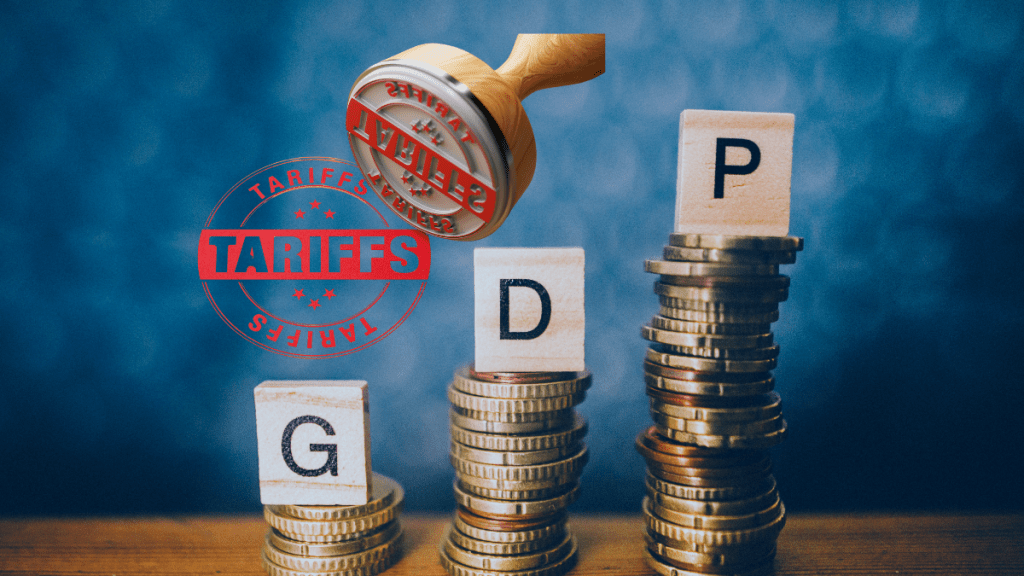The proposed doubling of extra tariff on Indian goods to 50% may shave off India’s economic growth by anywhere between 40 to 100 basis points on an annualised basis, according to analysts.
The Direct Economic Fallout: Growth Projections Revised
Goldman Sachs had previously estimated a potential direct impact of around 0.3pp annualised to India’s real GDP growth, following Trump’s late July announcement of 25% tariff on Indian imports.
“If the new additional duty (including exclusions) is enforced, then that would constitute a potential incremental drag of around another 0.3pp annualised,” Goldman Sachs said Thursday, adding that it is not making any changes to its growth forecasts at the moment, given that there is a three-week window for negotiations until the new incremental tariffs come into effect.
Given that over a third of the current financial year is over, the impact on FY26 growth will be correspondingly less. The Reserve Bank of India has kept GDP growth forecast unchanged at 6.5% for the current fiscal year.
In a report, Bloomberg said Trump’s additional tariffs on India will further damage the country’s already slowing economy and shrink its gross domestic product (GDP) by as much as a percentage point, citing analysts.
Research firm Nomura said:” We had previously flagged a downside risk of ~0.2pp to our baseline FY26 GDP growth forecast of 6.2% in reaction to the initial 25% tariff imposition. If the additional penal 25% materialise, then the hit could be higher, depending on their duration.”
Morgan Stanley in a research report, said if tariffs persist at high levels (50%) for a longer period of time (12 months), “growth could see downside risks of 40-80bps (assuming no mitigating factors).” However, if downside risks persist, we anticipate policy support to step up to bolster domestic growth conditions, it said.
Goldman Sachs’ forecast is based on India’s goods exports exposure of roughly 4% of GDP to US final demand and a goods export demand elasticity of ~0.5 as referenced in the IMF study. There are indirect impacts on real GDP growth through trade-related uncertainty as well, it said.
Weighing the Costs: Tariffs vs. Russian Oil Shift
Russia’s share of Indian crude oil imports has picked up sharply from negligible levels prior to FY23 to around 36% of the total in FY25. India’s crude oil imports were also sourced from Iraq (20% of total in FY25), Saudi Arabia (14%), the UAE (9%) and the US (4%).
The implied discount on Russian crude oil for Indian refiners has significantly fallen to around $2.2/bbl in FY25, from more than $12/bbl in FY23.
If India chooses to shift from Russian crude oil imports, there will be two factors at play, Nomura said. One, India’s import bill will increase to the extent of the lost discount, which we estimate is only an additional cost of about $1.5 billion (~0.04% of GDP) annually. Two, some refining margin squeeze is likely, but Indian refiners may choose to pass on the incremental cost to their customers. As such, the direct impact appears manageable, Nomura said.
However, a bigger risk is a secondary impact from India’s excess demand, leading to higher oil prices globally, Nomura said.
Every dollar rise in global crude oil prices could add costs of about $1.8 billion (~0.05% of GDP) annually.
“Our baseline forecast for the current account deficit in FY26 is 0.8% of GDP and the impact of any reshuffle from Russian to other sources of oil should be limited to ~0.1% of GDP or less, assuming that global crude oil prices do not spiral upwards,” Nomura said. Domestically, the government is likely to keep pump prices stable, limiting the risk to growth and inflation.
However, Trump’s announcement of cumulative tariff rate of 50% on India will likely be a more material headwind for Indian exports, it said.
The resulting steep 50% cumulative tariff would be similar to a trade embargo, and could trigger a sudden stop in affected export products. The lower value addition and thinner margins across a number of industries (e.g., textiles, gem & jewellery) could jeopardise operations, especially of smaller firms that will struggle to compete. The effective tariff rate also makes the burden on India similar to that of China and much higher than ASEAN economies (19-20%), putting India’s goods at a significant disadvantage, Nomura said.

